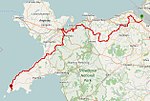TSS Duke of Lancaster (1955)
1955 shipsFerries of WalesFerries of the United KingdomIMO numbersPages with disallowed DISPLAYTITLE modifications ... and 6 more
Passenger ships of the United KingdomShips and vessels on the National Register of Historic VesselsShips built by Harland and WolffShips built in BelfastShips of British RailUse British English from August 2017

TSS Duke of Lancaster is a former railway steamer passenger ship that operated in Europe from 1956 to 1979, and is beached near Mostyn Docks, on the River Dee, in north Wales. She replaced an earlier 3,600-ton ship of the same name operated by the London Midland and Scottish Railway company between Heysham and Belfast.
Excerpt from the Wikipedia article TSS Duke of Lancaster (1955) (License: CC BY-SA 3.0, Authors, Images).TSS Duke of Lancaster (1955)
Llwybr Arfordir Cymru,
Geographical coordinates (GPS) Address Website Nearby Places Show on map
Geographical coordinates (GPS)
| Latitude | Longitude |
|---|---|
| N 53.306452777778 ° | E -3.2357 ° |
Address
TSS Duke of Lancaster (The Funship)
Llwybr Arfordir Cymru
CH8 9DQ , Mostyn
Wales, United Kingdom
Open on Google Maps







